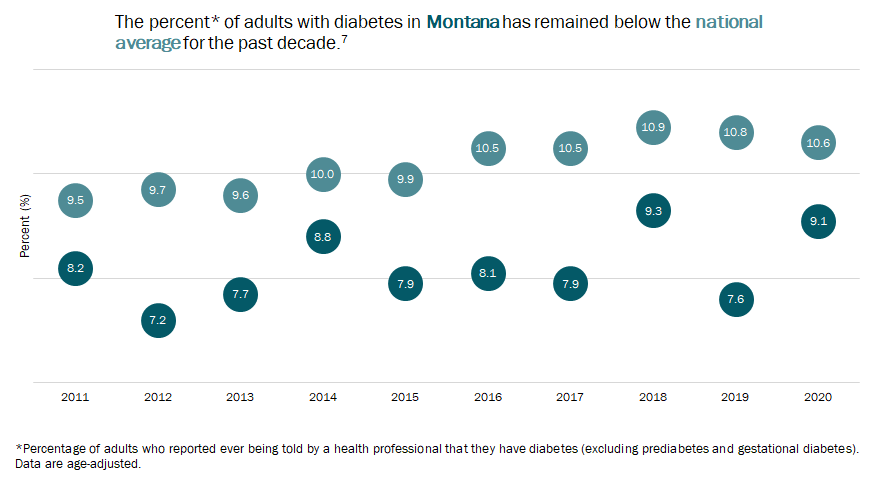Diabetes 101
Diabetes By The Numbers
- About 77,100 people in Montana currently have diagnosed diabetes. 1
- In 2022, over 38 million US adults had diabetes, and 1 in 4 didn't know they have it. 2
- Diabetes was the eighth (8) leading cause of death in the US in 2020. 3
- Diabetes is the No. 1 leading cause of end-stage kidney failure and adult blindness. 2
- Many adults are estimated to have prediabetes, but not know it. Although it is estimated that over 1 in 3 adults in Montana have prediabetes, in 2020 only 9% reported ever being told they had prediabetes. 1
- Across the US it was estimated that 97.6 million adults (38% of the adult US population) aged 18 years or older had prediabetes. 2
What is Diabetes?
Diabetes is a chronic (long-lasting) condition that occurs when your body either doesn't make enough insulin or can't use it as well as it should.
When you eat, the food it is broken down into sugar and released into your bloodstream. This causes your blood sugar to go up and signals your pancreas to release insulin. Insulin acts like a key to let the blood sugar into your body's cells for use as energy. If you have diabetes, this affects how your body is able to turn food into energy.
There isn't a cure for diabetes, but by following a healthy lifestyle (losing weight, eating healthy, staying active), taking medication as needed, following up with your provider and getting diabetes self-management education support (DSMES), the impacts of diabetes on your life can be reduced.
Types of Diabetes
There are three main types of diabetes:
Symptoms of Diabetes
Symptoms of diabetes can vary from person to person and some symptoms are so mild that they may go unnoticed. If you are concerned that you may have diabetes it is important to follow-up with your healthcare provider.
Some of the most common symptoms include:
- Frequent urination (going to the bathroom)
- Feeling very thirsty
- Feeling very hungry (even when you are eating)
- Fatigue
- Blurry vision
- Cuts that are slow to heal
- Weight loss (type 1)
- Tingling, pain, or numbness in hands or feet (type 2)
Remember early detection and treatment can help prevent or decrease complications associated with diabetes.
Type 1
- Type 1 diabetes is a chronic (long-lasting) condition where the body produces little to no insulin. Symptoms of type 1 diabetes can develop quickly and is usually diagnosed in children, teens, and young adults.
- Approximately 5-10% of the people who have diabetes have type 1.
- Treatment for type 1 diabetes includes medication and managing blood sugar levels, diet, and exercise.
Type 2
- With type 2 diabetes, your body doesn't use insulin well and can't keep blood sugar at normal levels.
- It develops over many years and is usually diagnosed in adults (but more and more in children, teens, and young adults).
- You may not notice any symptoms, so it's important to get your blood sugar tested if you're at risk.
- Type 2 diabetes can be prevented or delayed with healthy lifestyle changes, such as losing weight, eating healthy food, and being active.
- About 90-95% of people with diabetes have type 2.
Gestational Diabetes
- Gestational diabetes develops in pregnant women who have never had diabetes.
- If you have gestational diabetes, your baby could be at higher risk for health problems.
- Gestational diabetes usually goes away after your baby is born but increases your risk of type 2 diabetes later in life.
- Your baby is more likely to have obesity as a child or teen, and more likely to develop type 2 diabetes later in life too.
Prediabetes
- In the United States, 96 million adults-more than 1 in 3-have prediabetes.
- What's more, more than 8 in 10 of them don't know they have it.
- With prediabetes, blood sugar levels are higher than normal, but not high enough yet to be diagnosed as type 2 diabetes.
- Prediabetes raises your risk for type 2 diabetes, heart disease, and stroke.
- The good new is if you have prediabetes, a CDC-recognized lifestyle change program can help you take healthy steps to reverse it.
- Get started on your path to preventing type 2 diabetes with the CDC path 2 prevention tool.
- American Diabetes Association. (2024). The burden of diabetes in Montana. Retrieved from https://diabetes.org/sites/default/files/2024-03/adv_2024_state_fact_montana.pdf.
- Centers for Disease Control and Prevention (CDC). (2024). Prevalence of both diagnosed and undiagnosed diabetes. Retrieved from https://www.cdc.gov/diabetes/php/data-research/index.html.
- CDC. (2022). Leading causes of death. Retrieved from https://www.cdc.gov/nchs/fastats/leading-causes-of-death.htm.







